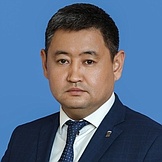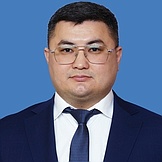Regional flags and emblems


PROFILE
Established 4 November 1920 as Kalmyk Autonomous Region
From 1935 Kalmyk ASSR
From 1991 Kalmyk SSR
From 1992 Republic of Kalmykia — Khalmg Tangch
From 1996 Republic of Kalmykia
Capital Elista
The Republic of Kalmykia is part of the Southern Federal District
Area 74,700 sq km
Population 267 400 (2025)
Ethnic groups
(2020 National Census, %)
Kalmyk – 62,47
Russian – 25,71
Dargin – 2,83
Kazakh – 1,72
Turk – 1,55
Chechen – 1,10
Other – 4,62
Administrative divisions (2024)
Municipal districts − 13
City districts − 1
Rural towns − 2
Rural districts − 111
Geography and climate
The Republic of Kalmykia is in the western part of the Caspian lowland and is washed by the Caspian Sea in the southeast. Most of the area is located in the semi-desert zone where there is little surface water. The Caspian Sea coast is low and marshy. Kalmykia stretches 423 km from west to east and 448 km from north to south and borders on the Republic of Dagestan, the Stavropol Territory, the Rostov, Volgograd and Astrakhan regions.
The main rivers in Kalmykia are Yashkul, Amta-Burgusta, Kamennaya, Zelmen, and Kara Sal, which source from natural springs – there have been as many as 110 of them discovered in the area. The local lakes include Sarpinskiye, Barmantsag, Tsanan-Nur, Batyr-Mala, Sostinskiye, Oktyabrsky Spills, Manych-Gudilo, Tsygan-Khak; there are also the Chograiskoye and Gorodovikovskoye manmade reservoirs.
The climate in Kalmykia is distinctly continental. The average temperature in January is –2.7°C, and in July, +26.5°C. The average amount of precipitation in January is 17 mm, and in July, 19 mm. The vegetation period with temperatures above +10°C is between 180 and 213 days long.
Chornye Zemli (Black Lands), a major federal state biosphere natural reserve, is located in Kalmykia. The republic also has three federal state nature reserves, nine regional state nature reserves, one nature park, and nine nature landmarks of regional level.
Government
The legislative branch in the Republic of Kalmykia is the People's Khural (Parliament), which is the permanent, representative and only body of legislative authority in the region. Elected for a term of five years. It consists of 27 deputies with 17 running in single mandate constituencies and the other 10 in the republican electoral district according to the proportional electoral system.
The current People's Khural was elected in September 2023 and will serve until September 2028.
The executive branch of the Republic of Kalmykia is represented by the Head of the Republic of Kalmykia, the Government of the Republic of Kalmykia and other bodies of executive authority of the republic. The Government of the Republic of Kalmykia is the supreme and permanent body of executive authority.
The Head of the Republic of Kalmykia is the republic’s highest-ranking official, who determines the system and structure of the bodies of executive authority of the Republic of Kalmykia.
The Head of the Republic of Kalmykia forms the Government of the Republic of Kalmykia, which is accountable to him.
The Head of the Republic of Kalmykia is elected for a term of five years by citizens of the Russian Federation permanently residing in the republic. The term of office of the current incumbent expires in September 2029.
Economy and natural resources
One of the main natural resources in the republic is land, which forms the basis of the Kalmyk economy. Farmlands account for about 85% of local land. Agriculture supplies more than 30% of the gross regional product.
The Caspian steppes and semi-deserts provide favourable conditions for keeping sheep and cattle in pastures all year round. Farm products lead the regional economy, mainly livestock (mostly beef cattle, meat and fine wool sheep). Livestock accounts for more than 76% of all agricultural products in the region. The main types of local crops include grains, sunflower, vegetables, melons, potatoes, and fodder.
Industry accounts for slightly over 3% of the gross regional product. The republic has about 350 large and medium-sized industrial companies. The leading industries are fuels (oil, natural gas), power generation, construction materials, and the food industry (meat canning, meat, and sausage). There are some well-developed traditional kinds of folk art, such as carving and painting on wood, embroidery, and processing of silver.
The Republic of Kalmykia is one of the regions with proven industrial oil and gas reserves and is a highly promising territory for oil and gas prospecting. The land of Kalmykia contains large hydrocarbon deposits of national significance, chemical raw materials (bischofite, nitrogen, natural gas, iodine, bromine, etc.), rare-earth metals, and building materials (brick and Ceramsite clays, limestone-shell, clay-gypsum, construction and silicate sands).
Culture and tourism
The culture and mentality of the Kalmyk people is rooted in the general Mongol and Oirat traditions, which evolved during centuries of historical development. Later, as Kalmyks strengthened their political, economic and cultural ties with other peoples of Russia, especially Russians, the Kalmyk culture began to acquire new features. These new features, while enriching and transforming the inherited traditions, formed the foundation for the modern original culture of the Kalmyk people, which has taken its current shape taking into consideration new historical conditions.
The Kalmyk culture and art are represented by theatres, museums, libraries, clubs, the regional art school, children's music and art schools, art schools, and professional music and dance companies. The republic is renowned for its multitude of Buddhist temples (khuruls), the foremost of which is Golden habitation of Shakyamuni Buddha, and other historic sights.
The republic marks traditional holidays of Zul, Tsagan Sar, Christmas, Nauryz, Yuletide and Farewell to Winter; folk song, dance, and oral folk art contests are held, and folk artists exhibitions. Half-forgotten folk songs, proverbs, customs, and holidays are now returning, and popular groups and clubs play a significant role in these projects.
Kalmykia has much potential for attracting tourists. There are unique nature landmarks, protected areas, rich vegetation and rare birds. It is the place through which the Great Silk Road passed, the Khazars lived and the Golden Horde built its cities. The remains of Saray-Berke, the second capital of the Golden Horde, are still there. Kalmykia is a great historical crossroad and the geographical center of the Eurasian continent.
The development of tourism in Kalmykia has been greatly facilitated by its advantageous geographical position. One of the main features of local tourist products is their exoticism, which is directly associated with the area’s unique natural landmarks, specific ethnography and its historical and cultural environment. Amid the growing concerns on how best to conserve nature, ecotourism is growing in Kalmykia as an environmentally safe form of rest and travel.


